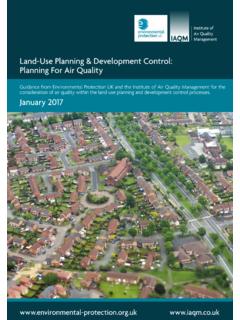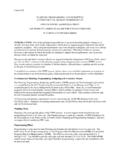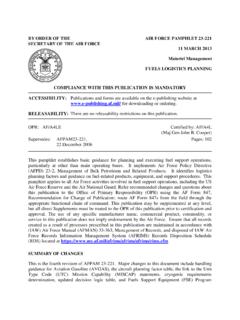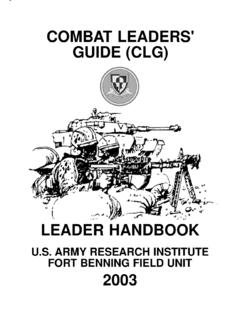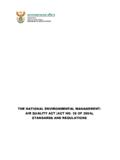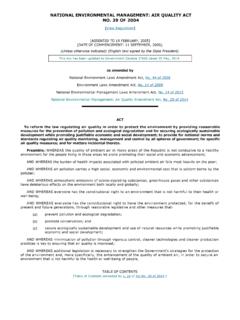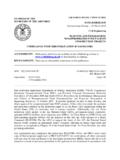Transcription of Guidance on the assessment of odour for planning …
1 IAQM u Guidance OdourGuidance on the assessment of odour for ofAir QualityManagementVersion - July 2018 IAQM u Guidance Odour2 Acknowledgements 3 Record of substantive amendments 41. Foreword 62. Introduction 73.
2 assessment of odour 114. Using odour assessment tools 145. odour benchmark/ odour assessment criteria 176. Drawing conclusions from assessment results 237. odour Management Plans 24 Appendix 1 - Predictive assessment tools 28 Appendix 2 - Sniff testing 37 Appendix 3 - Case law and appeals 43 Appendix 4 - Comparison of OMP requirements
3 In Guidance 44 Glossary 46 Abbreviations and acronyms 49 Table 1 : Description of the FIDOL factors 8 Table 2 : Receptor sensitivity to odours 12 Table 3 : IAQM suggested descriptors for magnitudes of odour effects 13 Table 4: Summary of odour assessment 15 Table 5: H4 benchmark odour criteria 19 Table 6: Proposed odour effect descriptors for impacts predicted by modelling 21 Most Offensive odours Table 7.
4 Proposed odour effect descriptors for impacts predicted by modelling 21 Moderately Offensive odours Table 8 : Recommended content of an OMP for planning purposes 26 Table 9: Examples of risk factors for odour source, pathway and receptor sensitivity 29 Table 1 0 : Risk of odour exposure (impact) at the specific receptor location 31 Table 11: Likely magnitude of odour effect at the specific receptor location 32 Table 12 : Example summary of the likely odour effects at existing sensitive receptors 32 Table 13: Some approaches for addressing uncertainty in odour modelling 36 Table 14: VDI 3940 odour intensity scale 37 Table 15: Matrix to assess the odour exposure neutral and unpleasant odours) at time 39and place of sampling Table 16: Matrix to assess the odour effect at individual receptors 41 Figure 1.
5 From odour formation to complaint 9 Figure 2: Plan, do, check, act framework 25 Box 1: Definitions of impacts and effects used in this Guidance 11 Box 2: Example of multi-tool odour assessment of site suitability 14 Box 3: What is an odour Management Plan? 24 Box 4: Example of sniff test sampling procedure 39 Box 5.
6 Checking the sensitivity of odour assessors 41 ContentsIAQM Guidance on the assessment of odour for planning 3 IAQM u Guidance OdourAcknowledgementsAcknowledgements: This Guidance was produced as a result of the voluntary contribution of the members of a Working Group, for which IAQM is very grateful. This Guidance represents the views of the IAQM and not necessarily the individual members of the working of the working group Michael Bull, ArupMembersAlun McIntyre, SKMD arren Hall, AmecGordon Allison, CH2M HillJethro Redmore, RECJon Pullen, RPS planning & DevelopmentLaurence Caird, air quality ConsultantsMatthew Stoaling, SLR ConsultingRuth Fain, Golder AssociatesGraphic Design: Darren Walker ( )Suggested citatation: Bull et al (2018).
7 IAQM Guidance on the assessment of odour for planning version , Institute of air quality Management, London. the Institute of air quality Management (IAQM): The IAQM aims to be the authoritative voice for air quality by maintaining, enhancing and promoting the highest standards of working practices in the field and for the professional development of those who undertake this work. Membership of IAQM is mainly drawn from practising air quality professionals working within the fields of air quality science, air quality assessment and air quality photos: Jon Pullen Cover photo: Michael BullCopyright statement: Copyright of these materials is held by the IAQM. We encourage the use of the materials but request that acknowledgement of the source is explicitly : IAQM c/o Institution of Environmental Sciences 3rd Floor 140 London Wall London EC2Y 5DN T: +44 (0)20 7601 1920 E: May 2014 updated July 2018 Record of substantive amendmentsOriginal locationRevised locationAmendment madeGeneralName change: Version - 2018 updateGeneralChanges to shading of tablesPage 4 Deletion: "national Government"Page 4 Addition: "The evidence presented to justify a decision should be examined carefully and the base science presented should be the main consideration when reviewing the outcome of an appeal.
8 " paragraph 1 Deletion: "addresses that need" paragraph 1 Addition: "produced various Guidance documents on odour but these were withdrawn in September 2017" paragraph 1 Change: "emissions" to " odour exposure"Table 3 Addition: "relative" to " odour Exposure (Impact)" paragraph 7 Addition: "former" before "Defra Code of Practise"Table 4 Deletion: "Draft method pred264086 is currently going through the CEN voting process"Table 4 Change: Final column title to "Notes" paragraph 1 Addition: "and other statutory consultees" paragraph 1 Addition: "on their own Guidance " paragraph 2 Addition: "The CIWEM Position Statement was produced in 2012 by a group of odour assessment practitioners. The statement is based on their interpretation of the available evidence at the time and the experience of members of the group.
9 No new research was used to produce this statement." 43 Move entire segment to new position as Appendix : Taking into account the available scientific evidence and the collective experience of IAQM members involved in drafting this Guidance , the odour concentration change descriptors together with impact descriptors in Table 6 are proposed for an odour at the offensive end of the spectrum. These adopt the C98 as the appropriate frequency metric, encompasses the 1 to 10 ouE/m3 concentration range referred to above and also considers also the potential sensitivity of different receptors. It is also consistent in format and concept with other Guidance in the air quality field. Examples of receptors that fall into the above sensitivity categories are contained in Table 2.
10 For odours that are less unpleasant, the level of odour exposure required to elicit the same effect may be somewhat higher, requiring professional judgement to be applied. For example, odours from sewage treatment works plant operating normally, non-septic conditions, would not be expected to be at the most offensive end of the spectrum (Table 5) and can be considered on par with moderately offensive odours such as intensive livestock rearing. Table 7 below shows the impact descriptors proposed for a moderately offensive odour . Version July 2018 IAQM u Guidance Odour4 Original locationRevised locationAmendment madePage 21 Addition: Moderately offensive odours table (Table 7)Page 22 Deletion: Remove reference 21 Table 7 Table 10 Deletion: "if possible" from rows 2 and 3 Table 7 Table 10 Change: If the measures are not sufficient, they need to be tightened further or else possibly ceasing/reducing odorous operations" to "It should be stated that if all the measures are shown not to be sufficient, then they will need to be tightened further or else, possibly ceasing/reducing odourous operations.



